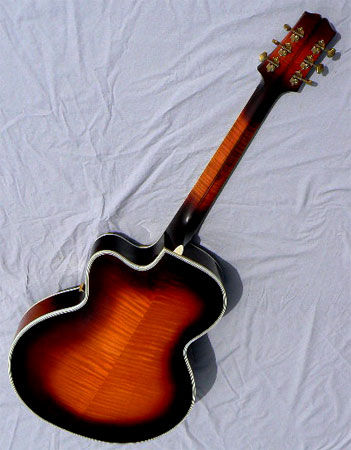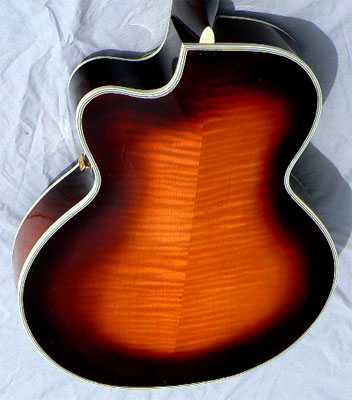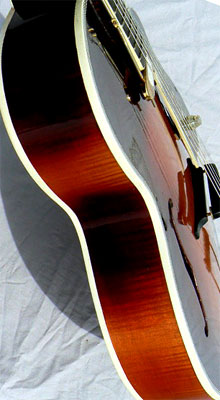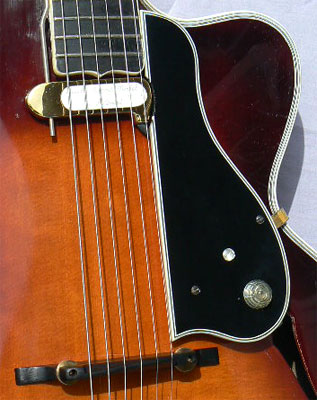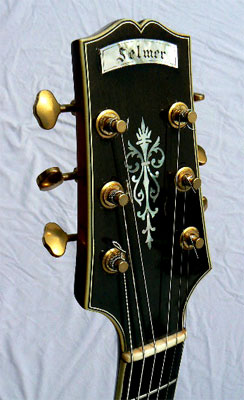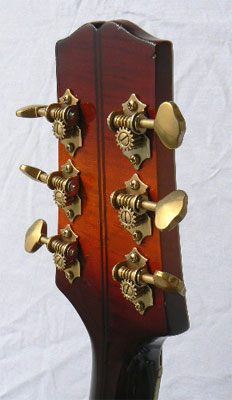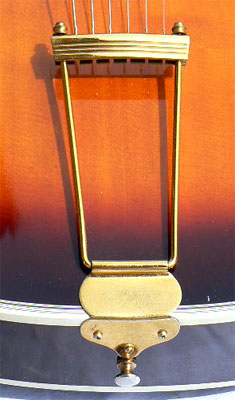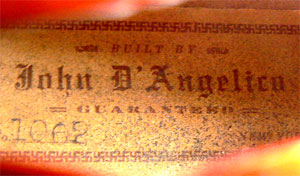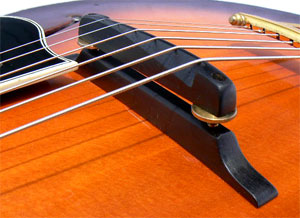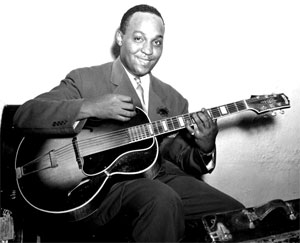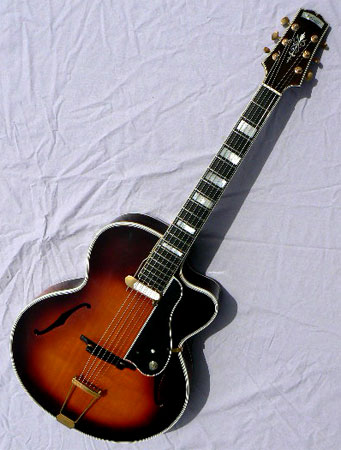
Home / Instruments /Accessories / Ordering / Tips / Friends
archtop.com
1934 Selmer D'Angelico
Price and Status: For pricing and hold status of this instrument, please check here. If this instrument does not appear on the Instruments page it has been sold. To be notified of examples of this or any other model in the future, please email your specific requests to [email protected].
Serial number: 1062, rectangular John D'Angelico label. Ledger date: 05/04/34
Body size at lower bout:16 1/2" Scale length: 25". Nut width: 1 3/4" Body depth: 3 3/8"
Finish: Sunburst finish, nitrocellulose lacquer type
Materials: Solid handcarved flame figured maple back and sides; solid bookmatched handcarved Adirondack spruce top; solid tiger flame maple neck with 3-ply walnut/maple centerstripe; mother of pearl block fingerboard inlays; vine-and-torch peghead inlay, 11-ply body binding, bound fingerboard and headstock.
Hardware: Gold trapeze tailpiece, adjustable ebony bridge, triple-bound black bakelite pickguard; gold Guild/DeArmond Model 1000 Rhythm Chief pickup with volume control and 1/8" jack under pickguard; antiqued gold open-back Sta-Tite style 16X1 tuners with butterbean keys.
Notes: In the handwritten ledgers of John D'Angelico, the luthier recorded his output of instruments each with its serial number, date of completion and purchaser. While most of his creations were sold directly to individual customers, a small number of guitars were commissioned by retailers like Gravois Music and Silver and Horlund. Three of D'Angelico's earliest instruments share an particularly intriguing designation. Built over a seven month period between November 1933 and May of 1934, they are noted in the builder's hand as produced for a single notable customer: Selmer.
Best known for their superlative woodwinds, the Selmer name is renowned among guitarists for the distinctive acoustic jazz guitars made famous by Django Reinhardt and his followers. Barely a year after Selmer Paris produced the first of the Maccaferri design guitars in 1932, Selmer New York apparently contracted with John D'Angelico for a similar venture: to produce a number of archtop guitars under their prestigious name. For whatever reason, the arrangement was short-lived, and only three instruments were produced under the partnership. The whereabouts of the first two Selmer D'Angelicos remains unknown to us at this time. The third and final example, #1062, is presented here.
D'Angelico's earliest guitars were modeled closely after the original Gibson L-5, the first commercially successful archtop guitar. The Selmer D'Angelico is squarely in the mold of those first guitars, with a 16 1/2" parallel braced body, tapered 'snakehead' headstock, block inlaid ebony fingerboard with pointed finial, adjustable ebony bridge and gold trapeze tailpiece. Even the multi-bound pickguard echoed the sinewy contour of the early L-5 scratchplate. The graceful "vine-and-torch" peghead inlay and arched pearl block peghead logo is seen on a number of the earliest D'Angelicos, including #1002 as pictured in the Schmidt book, and others shown in Gruhn and Carter and Tsumura. Indeed, the most significant difference between this Selmer and D'Angelico's standard archtop of the day would appear to be the engraved gothic script logo. ( A photograph of Fats Waller guitarist Al Casey playing one of the Semer DA's is shown below, courtesy of Steve Bravante.)
Documentation from Mandolin Brothers, who last sold this instrument almost a decade ago, suggests the guitar was returned to D'Angelico and fitted by the maker with a cutaway, at which time the binding and finish would have been replaced as well. It appears likely that the original pickguard may have been recontoured and rebound at that time, and the medium jumbo fret wire, still retaining its nibs at the binding, suggests to us that the work was done sometime late in D'Angelico's career. A gold Guild-logo DeArmond Model 1000 Rhythm Chief was installed, with a pickguard-mounted volume control and 1/8" mini-jack connector. Finally, an elegant set of period-correct antique gold 16 X1 butterbean tuners has been recently fitted to the headstock.
The soundboard is carved of extraordinary tonewood, with grain so tight at the centerseam as to approach invisibility. The back and neck in turn are shaped from wonderfully bookmatched tiger flame maple, arrayed in a dramatic chevron pattern. On the back, the maker's original registration dots may be seen near the heel and endblock, and a single short grainline crack has been immaculately resealed near the cutaway. The binding is tight to the body and in excellent condition, and apart from a few random scratches near the guard and some old thumbwear, the finish is remarkably free of wear. The neck profile is a smooth gentle D, surprisingly contemporary in profile, and the fingerboard is straight with excellent fretwork. In a signature touch, D'Angelico drilled out the underside of the bridge base to lighten its mass and increase resonance. The voice is notable for its clarity and musicality, with an elegance and refinement throughout the tonal register, all of which is warmly conveyed by the vintage DeArmond pickup.
Sixteen inch cutaways have experienced a remarkable popularity in recent years, and this body size is one of the rarest among vintage D'Angelicos. The guitar is supplied with a copy of its entry in D'Angelico's hand-written ledger. A singular opportunity to acquire one of the rarest and most distinctive guitars of the 20th century.
Setup: The frets have been precision leveled, recrowned and polished as necessary; bridge height adjusted; bridge compensation set; string slots at nut and bridge inspected; bridge foot contour inspected; bridge radius inspected; bridgewheels and tuners lubricated; fingerboard and bridge oiled; body and neck cleaned and hand polished.
This instrument is strung with medium gauge nickel roundwound strings
(.013-.057). The guitar will accommodate lighter or heavier gauge strings,
according to preference. String action is set at 5/64" to 6/64"
at the 12th fret, with moderate relief for acoustic playing with medium
strings. The action may be lowered or raised to your requirements with the
adjustable bridge.
Case: Vintage black alligator hardshell case.
